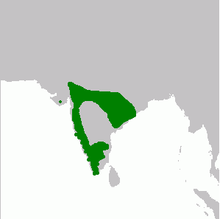Indian scimitar babbler
| Indian scimitar babbler | |
|---|---|
 |
|
| Scientific classification | |
| Kingdom: | Animalia |
| Phylum: | Chordata |
| Class: | Aves |
| Order: | Passeriformes |
| Family: | Timaliidae |
| Genus: | Pomatorhinus |
| Species: | P. horsfieldii |
| Binomial name | |
|
Pomatorhinus horsfieldii (Sykes, 1832) |
|
| Subspecies | |
|
P. h. obscurus Hume, 1872 |
|
 |
|
P. h. obscurus Hume, 1872
P. h. horsfieldii Sykes, 1832
P. h. travancoreensis Harington, 1914
P. h. maderaspatensis Whistler, 1936
The Indian scimitar babbler (Pomatorhinus horsfieldii) is an Old World babbler. It is found in peninsular India in a range of forest habitats. They are most often detected by their distinctive call which is an antiphonal duet produced by pairs within small groups. They are often hard to see as they forage through dense vegetation. The long curve yellow, scimitar-shaped bills give them their name. It has been treated in the past as subspecies of the white-browed scimitar babbler which is found along the Himalayas but now separated into two species, the peninsular Indian species and the Sri Lanka scimitar babbler (Pomatorhinus melanurus).
The most distinctive feature of this 22 cm long bird is the long down-curved yellow bill which is blackish at the base of the upper mandible. It has a striking head pattern, with a long white supercilum above a broad black band through the eye. The white throat and breast contrast with the dark greyish brown on the upperside and dark grey to black on most of the underside. The tail is broad, long and graduated. They have short, round wings and being weak fliers are rarely seen flying in the open.
Indian scimitar-babblers have long down-curved yellow bills, used to work through the leaf litter in search of their food which is mainly insects and berries. They can be difficult to observe in the dense vegetation they prefer, but like many other babblers, these are noisy birds, and the characteristic bubbling calls are often the best indication that these birds are present. The call itself consists of a loud fluty oop-pu-pu-pu followed immediately by a krukru. The second note is produced by the female and the duet is accurately synchronized. Leucistic plumages have been recorded.
It is the only scimitar babbler in Peninsular India. This species is found south of line between Rajasthan and Orissa.
The Old World babblers are a large family of passerine birds characterised by soft fluffy plumage. They are birds of tropical areas, with the greatest variety in southeast Asia. This species is very close to the Sri Lanka scimitar babbler which has in the past been treated as a subspecies. In the past, this species has been considered as a subspecies of the white-browed scimitar babbler (Pomatorhinus schisticeps) which is found along the Himalayan foothills. Molecular studies confirm this relatedness.
...
Wikipedia

